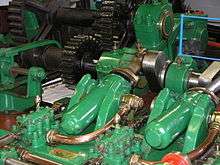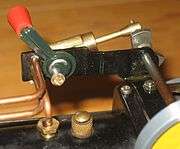Oscillating cylinder steam engine

An oscillating cylinder steam engine (also known as a wobbler in the US) is a simple steam-engine design that requires no valve gear. Instead the cylinder rocks, or oscillates, as the crank-shaft moves the piston, pivoting in the mounting trunnion so that ports in the cylinder line up with ports in a fixed port face alternately to direct steam into or out of the cylinder.
Oscillating cylinder steam engines are now mainly used in toys and models but, in the past, have been used in full-size working engines, mainly on ships and small stationary engines. They have the advantage of simplicity and, therefore, low manufacturing costs. They also tend to be more compact than other types of cylinder of the same capacity, which makes them advantageous for use in ships.
Operation

The steam needs to be fed into the end of the cylinder at just the right time in the cycle to push the piston in the correct direction. In the other direction, the steam needs to be allowed to escape from the cylinder. As the crankshaft rotates, the piston rod moves up and down (or side to side in the case of a vertical cylinder) as well as in and out. Because the piston rod is rigid and the piston itself is long relative to its diameter, this causes the cylinder to rock, or "oscillate" on its special mounting (trunnion). In the design usually found in a toy or model engine, a hole in the side of the cylinder (one at each end for a double-acting cylinder) and a pair of holes in the port block are arranged so that this rocking motion lines up the holes at the correct times, allowing steam to enter the cylinder in one direction and to escape into the atmosphere or condenser in the other direction.[1]
In full-size engines, the steam and exhaust ports are usually built into the pivot (trunnion) mounting. However, separate valves may be provided, controlled by the oscillating motion. This allows the cutoff timing to be varied to enable expansive working, as in, for example, the engine in the paddle ship PD Krippen. Alternatively, expansive working can also be provided by means of Woolf compounding, just as compactly if the two expansion stages are provided on either side of a single piston within a single cylinder, all arranged as a trunk engine (however, an oscillating cylinder engine does not benefit from the advantage of compactness that a trunk engine would otherwise provide, as it has that already from its own design features). Each approach to expansive working compromises the advantage of simplicity but still retains the advantage of compactness.[2]
Reversing
An oscillating cylinder engine cannot be reversed by means of the valve linkage (as in a normal fixed cylinder) because there is none. Reversing of the engine can be achieved by reversing the steam connections between inlet and exhaust or, in the case of small engines, by shifting the trunnion pivot point so that the port in the cylinder lines up with a different pair of ports in the port face. In the latter case, the fixed port face is usually provided with three ports, the central one being the steam feed and the outer two being exhausts, only one of which being in use at any time, depending on the required direction of running.
Marine
Hydraulic motors

Single-acting oscillating hydraulic motors were used for early hydraulic machinery, such as that produced by William Armstrong for the development of Victorian civil engineering, particularly around docks and moving bridges.
Examples
| Examples of oscillating cylinder steam engines | ||||||
|---|---|---|---|---|---|---|
|
See also
| Wikimedia Commons has media related to Oscillating cylinder steam engines. |
- Elbow engine - another cylinder-ported engine, not requiring additional valvegear
- Carpet railway – the 'Birmingham Dribbler' toy locomotives used this type of engine


